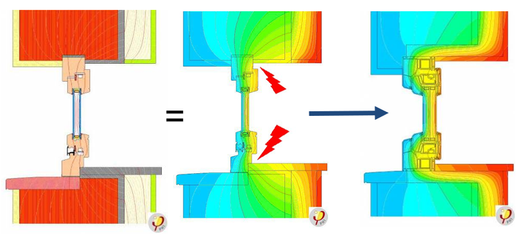This post is one part in a series about high-performance window installation:
Part 1: How to Prep the Rough Opening
Part 2: Positioning the Window in the Rough Opening - YOU ARE HERE
Part 3: Exterior Window Taping
Part 4: Interior Window Airsealing
Part 6: Window Installation Quality Control
After the window’s rough opening has been waterproofed (see our companion blog post on prepping the rough opening) and the EXTOSEAL ENCORS has been installed to protect the sills the location is now ready to receive the window unit.
The connection from the glass to the window frame and from the window frame to the rough opening are the thermally weak locations for the unit. Ideally the window unit located in the middle of the insulation to best prevent any thermal bridging.

THERM modeling showing thermal performance based on window unit location
If the wall assembly has only exterior insulation then it’d be best to build a window buck or use a high density EPS to be able to locate the unit within the middle of the exterior insulation. This approach can create a horizontal lip at the header that needs water and vapor protection with EXTOSEAL ENCORS since water can pool at this location.
Overlap the Window Frame with Insulation
Sometimes aesthetic design choices will force the window placement to be in a less than ideal location from a thermal standpoint. If the unit is located on the interior side of the framing then it’s possible to use a thin layer of board insulation to overlap the frame on the exterior. If the unit is located on the exterior side of the framing then it’s possible to use a thin board insulation to overlap the frame from the interior.

Left image shows rigid foam insulation used to overlap the interior side of the window frame. The rigid foam can have vapor permeability concerns since it tends to be a vapor retarder.
Right image shows mineral wool insulation used to overlaps the interior side of the window frame. The mineral wool insulation is vapor permeable.
For these options the rough opening will need to be larger than the window unit to give the space for the insulation overlap. Tapered rigid foam boards are commonly used for the exterior insulation frame overlap because it creates a pitch to promote drainage and offers compressive strength for installing a finish material.









